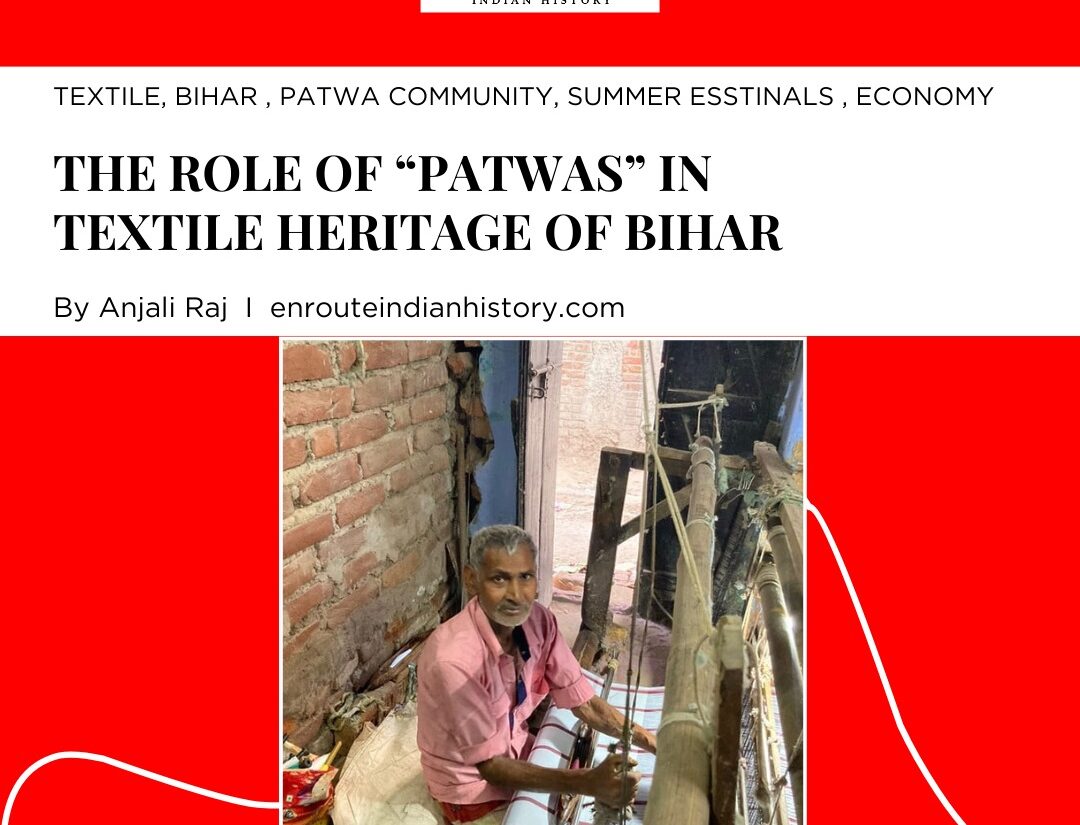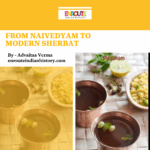

[source: news click; how handloom weavers produce clothes]
Who are Patwas? Traditionaly those who who work with pats which means thread Patwatoli, located in Manpur district of Gaya, Bihar, derives its name from the settlement of Patwas, a community renowned for crafting cotton textiles such as gamchas, bedsheets, and rumals, which are essential commodities, particularly during the summer months in Bihar. Over time, Patwatoli has earned the moniker “Manchester of Bihar” due to its significance in the textile industry.
While some Patwas operate small-scale home-based businesses, others have managed to establish small manufacturing plants, but none of them become a top tier industrialist. Despite their prominence, Patwatoli has faced numerous challenges, including a lack of adequate government support, which has contributed to fluctuations in their fortunes, in status quo Patwatoli has ceased to be the Manchester of Bihar as it struggles to keep up with the rapid pace of technological advancement demanded by the capitalist world.
Despite these obstacles, the resilient community of Patwatoli remains dedicated to preserving their weaving legacy. They have continuously endeavored to overcome setbacks and revitalize their craft, striving to ensure the continued prosperity of their community and the preservation of Bihar’s rich textile heritage.
Background
In tracing the historical migration of the Patwa community, one significant figure emerges: Raja Man Singh, a prominent Navaratna of the Mughal Emperor Akbar. Raja Man Singh orchestrated the relocation of the Patwa people from Rajasthan to Gaya, Bihar, where he settled them near the Vishnu Pad Temple alongside the Falgu (Niranajana) River. This strategic move was motivated by the customs of Hindu Mythology, particularly the tradition of Pind Daan, which necessitates offering a piece of cloth in ancestor worship. In response to this custom, Raja Mansingh facilitated the establishment of the Patwa colony known as Manpur, in honor of his patronage.

[source : news click, Miharu.in ; similarity between Rajasthani patwa jewellery and Bihari patwa clothe the color pattern is veru similar]
The cultural connections between Gaya’s Patwa community and their roots in Rajasthan are evident in various aspects, notably in jewelry designs and temple architecture. These elements serve as tangible links bridging the geographical gap between Gaya and Rajasthan.
In contemporary times, the descendants of the Patwa community have spread far and wide, with a significant population now residing in Mumbai. The Patwa community in Mumbai boasts a population exceeding 500,000 individuals, many of whom have diversified from their traditional occupations into various professions. While retaining their identity as part of the Baniya community, the Patwa people have integrated into urban life, contributing to the vibrant tapestry of Mumbai’s cultural landscape.
Patwatoli culture and traditions
In Patwatoli, a village renowned for its rich cultural blend of Hindu and Muslim communities, weaving holds a significant place in both tradition and daily life. Despite its modest population, every household boasts handlooms and charkhas, symbols of craftsmanship and heritage that endure even in the face of modernity. While the allure of education has drawn many of the younger generation towards academic pursuits, the art of handloom weaving remains a cherished aspect of Patwatoli’s identity.
Once revered as a cherished heritage, the decline of the handloom industry has prompted shifts in societal aspirations. While some have turned towards education, with Patwatoli gaining recognition for producing talented IITian students, the village remains deeply rooted in its traditional values.
However, amidst this cultural pride lies a strict adherence to caste traditions. Inter-caste marriages are met with vehement resistance, often resulting in severe consequences such as disinheritance from family properties. Despite the evolving landscape of education and modernity, the stronghold of caste norms continues to shape the fabric of social life in Patwatoli.
The heritage of Patwatoli in textile
If you go and search top cotton summer products products and distributors you will find all names are from Manpur ,Gaya. What makes Manpur a weaver frendily place , geographicaly it is situated on the banks of falgun rivers and availability of yarns which makes the work efficient for the textile workers. In Bihar, the use of gamchas isn’t merely a necessity but deeply ingrained in the culture. During summers, the demand for these traditional cotton products surges. Manpur is renowned for the art of BUNKARI producing many materials like gamchas , bedsheets, rumal,and various garments tailored to specific regional preferences. For instance, the demand for cotton dhotis from Manpur is exceptionally high in Punjab, while cotton lehengas and sarees are favored by tribal communities in Bihar and Jharkhand, often worn during marriages. The clothes are made by handloom and there are very less powerlooms for instance one handloom production typically yields around three lehengas within an 8 to 10-hour workday. Comparatively, powerlooms operate for 18 to 20 hours daily, generating a significantly larger output. With four powerlooms, only one worker is required, enabling continuous operation. This stark contrast underscores the efficiency disparity between handlooms and powerlooms in textile manufacturing. Women play a crucial role as active participants in the weaving industry, contributing significantly to the production process. Despite their integral involvement, they often face barriers accessing markets and earning fair compensation for their labor. Many women engage in weaving primarily to support their families, yet their contributions are undervalued in the market economy.
Patwatoli, known for its textile production, experienced a significant boost in 1991 with the introduction of industrial reforms. The influx of tools like handlooms transformed it into the textile hub of Bihar, earning it the moniker “Manchester of Bihar.” Almost every family was involved in this cottage industry, passing down the craft through generations. However, despite initial success, lack of technological advancements became a hindrance. As other industries embraced modern technologies, the traditional artisans struggled to keep pace, leading to a decline in prominence. The modernization of weaving in Patwatoli commenced in 1956 with the Indian government’s introduction of technological innovations in Manpur, primarily through the adoption of powerlooms. This initiative heralded the onset of industrialization in the region. Further advancements occurred in the 1980s when the Bihar government, under the leadership of Jagannath Mishra, distributed powerlooms to weavers. This program, known as Mangal Kargah (Auspicious Loom), played a pivotal role in boosting the weaving industry and promoting economic development in the area. Currently, weavers in Patwatoli are grappling with numerous challenges, prompting them to demand automatic machines. While powerlooms were initially distributed to some, subsequent government support has been lacking, exacerbating the difficulties faced by these artisans. The neglect of the weaving community has resulted in Patwatoli losing its prestigious title as the “Manchester of Bihar.” Many individuals are opting to abandon this traditional craft, leading to a decline in the area’s cultural heritage and identity. Weaving is not merely a means of livelihood for the Patwas; it is deeply intertwined with their culture and serves as a cornerstone of their identity. The erosion of this tradition signifies a loss not only of economic opportunities but also of a rich cultural heritage that has been passed down through generations. Urgent measures are needed to revitalize the weaving industry in Patwatoli, not only to safeguard the livelihoods of its artisans but also to preserve its invaluable cultural legacy for future generations.
Patwatoli holds significant importance for Bihar as the demand for its products remains consistently high. The craftsmanship displayed by the artisans in Patwatoli produces items of pure artistry, which have the potential to substantially boost Bihar’s economy.
REFERENCES
Bihar soon to perish? Handloom weavers in Patwa toli stare at uncertain future
https://www.newsclick.in/bihar-soon-perish-handloom-weavers-patwatoli-stare-uncertain-future
Patwa toli and Patwa culture.
https://abhayart.wordpress.com/2009/04/27/306/
https://theprint.in/india/this-bihar-weavers-business-is-booming-but-hes-not-a-happy-man/667544/
https://fliarbi.com/market.ai/india/list/cotton-gamcha/d/gaya/
- May 15, 2024
- 6 Min Read























